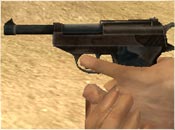|
AXIS WEAPONS
The bayonet was originally a defensive weapon. Infantry standing two or three deep, who adopted a square formation, could defend their position against a cavalry charge. Bayonet charges were rarely attempted until the enemy was retreating. The development of breech-loading rifles in the 19th century provided infantrymen with the firepower capable of beating off cavalry. After this, the bayonet turned from being primarily a defensive weapon to being a personal offensive weapon. The difficulties of fixing bayonets in battle led some armies to adopt permanently-attached bayonets which folded above or below the barrel of the rifle.

The Walther P38 is without a doubt one of the best known guns in the world, and when it was introduced in the German army in 1940, it was one of the most advanced guns of its age. Not only was it the first combat pistol in a major caliber that had a double action trigger, it even featured a combined safety/decocking lever on its slide. The gun is still build today, and although it is not a top-of-the-line gun any more, many of its features can be found in other combat guns.
The MP-40 (Machinenpistole 40) was the first submachine gun to be designed specifically designed for fast, economical manufacture, using stamped sheet metal and subcontracted assemblies wherever possible. This was one of the first firearms in which plastic was used as a substitute for wood and metal.
In 1943, the Reich put the 7.92x33mm cartridge and the MP43 in full scale production for this purpose. A few minor changes and the MP43 was produced the next year as the MP44. The way the story goes, the MP44 was later renamed StG44 or "sturmgewehr" -assault rifle- by Hitler himself. The title stuck and the rest is history.
In 1918, the pre-war weapons that dominated tactical thinking from 1914-17the magazine rifle, the heavy machine gun, and the high-explosive shellwere starting to give way to newer weapons, weapons conceived with the trench warfare in mind. The long-range marksman's rifle that had emerged from the Boer War was gradually being replaced by high-firepower, short-range infantry weapons. During the great German offensive of 1918, wherever supplies would allow, German Sturmtruppen carried the new, 9-mm MP-18 Bergmann submachine gun rather than the long, bolt-action Mauser rifle.
The 98 series was an extremely popular repeater rifle. It was used in the First World War in its longer form, and was then cut down in size and used in the Second World War in its new form as the 98k (k=kurz or short in English). Every soldier fighting for Germany had at least trained with this rifle, and for hundreds of thousands it had been their only weapon throughout the war.
Although originally not intended solely as snipers weapons, the G41/43 series ended up being Germany's first real attempt at developing a standard sniper arm utilizing the zf4 and zf4 k43 series of 4 power scopes. Even so, sniping effectiveness with the G43/zf4 was disappointing, mostly due to the rushed service of both components.
Development of this weapon was inspired by the early 1943 capture of American M9A1 Bazookas in the african campaign (Tunisia; other sources: captured lend-lease bazookas from the Eastern Front). To increase its basic potential it was decided outright to use a weapon caliber of 8.8cm (3.46 in.) instead of the Bazooka's 6cm (2.36 in.). It was designated Raketen-Panzerb chse ("Rocket Tank Rifle") and officially abbreviated RPzB but commonly referred to as Panzerschreck ("Tank Terror"), among the troops it was also known simply as the Ofenrohr ("stove pipe").
Basic German hand grenade - also called a 'stick grenade' or 'potato masher'. Although the stick allowed these grenades to be thrown farther than most others, it also added extra weight to the grenade and made them very cumbersome to carry in large numbers.
There are many types of explosives but they all pretty much fit into four main groups, Primary, Low, High, and Blasting Agents. Each of these groups is used for different things including blasting, military use, demolishing, and excavating. Some of these explosives were used hundreds of years ago and some are used now but you may see that we have progressed a lot since the first explosives.
Mines have been integral to military operations since World War I. They are laid to channel opposing troops into a specific area, to defend army flanks or a border zone, or to prevent anti-tank mines from being disabled. Many countries doctrine calls for careful mapping and marking of minefields, and clearance upon completion of the mission. But militaries have often failed to remove their mines. Thus, World War I-era mines turn up in Europe today, and millions of still-lethal mines left from World War II are strewn across the North African desert.
ALLIED WEAPONS
The bayonet was originally a defensive weapon. Infantry standing two or three deep, who adopted a square formation, could defend their position against a cavalry charge. Bayonet charges were rarely attempted until the enemy was retreating. The development of breech-loading rifles in the 19th century provided infantrymen with the firepower capable of beating off cavalry. After this, the bayonet turned from being primarily a defensive weapon to being a personal offensive weapon. The difficulties of fixing bayonets in battle led some armies to adopt permanently-attached bayonets which folded above or below the barrel of the rifle.
|

